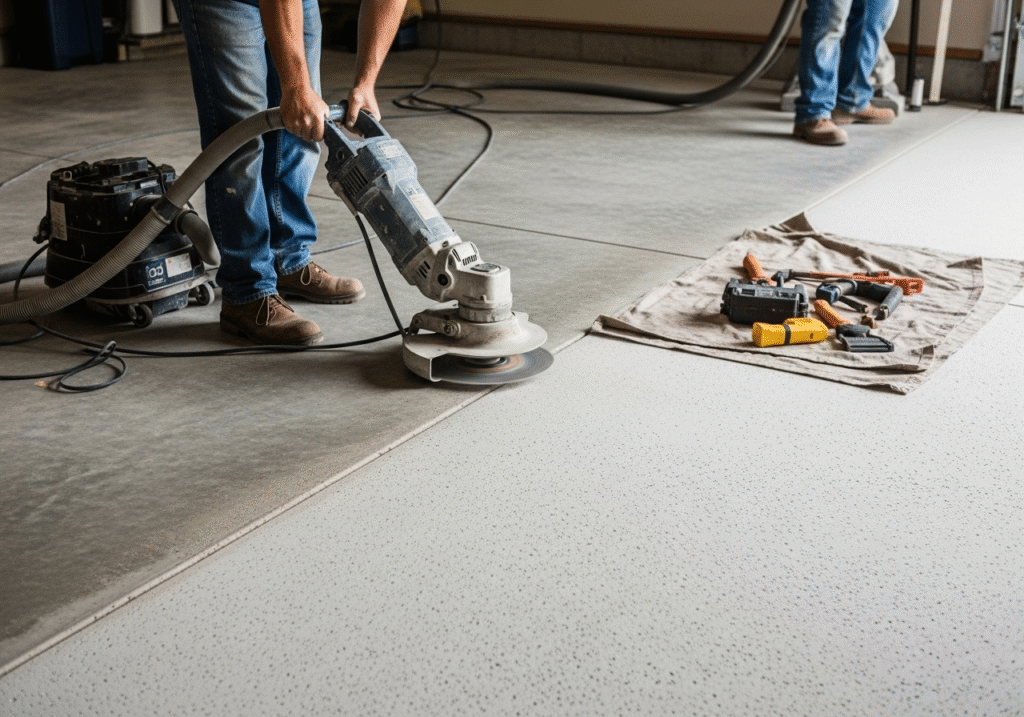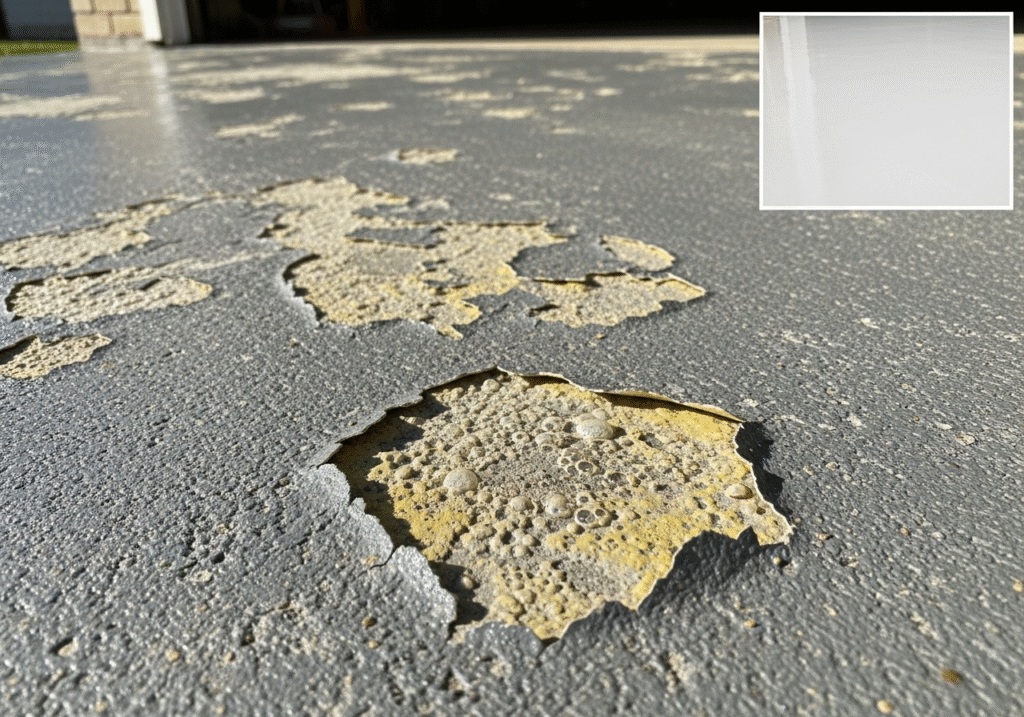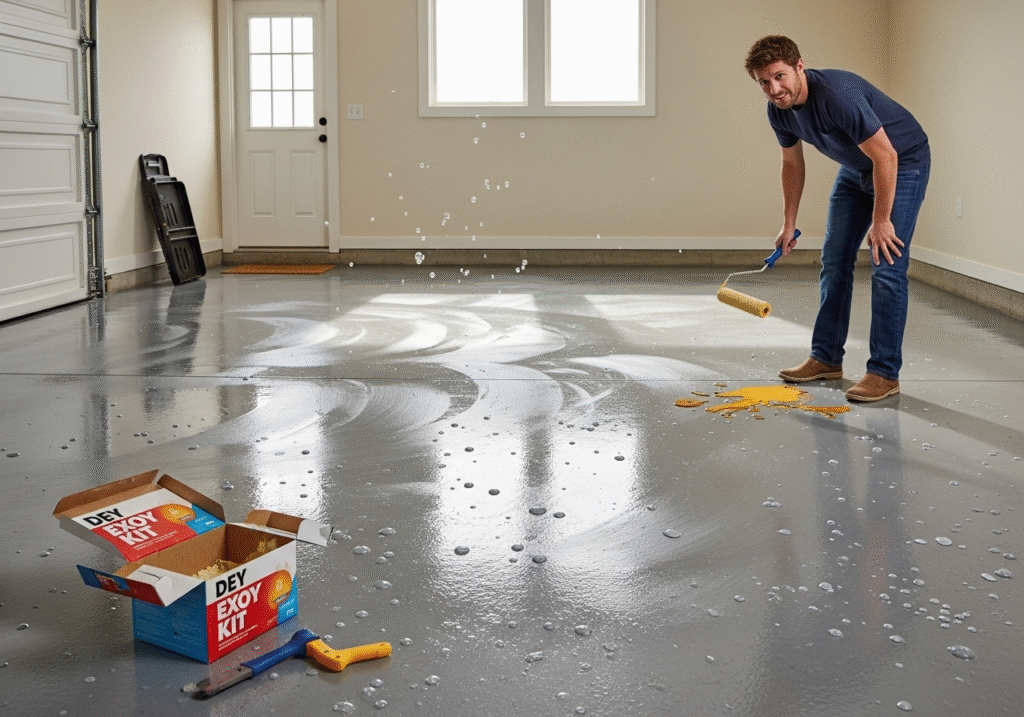Did you know that the lifespan of an epoxy floor can be cut in half by improper installation? While a professionally installed epoxy garage floor offers superior durability and a stunning finish, many homeowners and even inexperienced contractors in the Rollingwood, TX, area fall victim to common pitfalls. These mistakes lead to a host of frustrating epoxy garage floor problems that can ruin your investment.
This comprehensive guide will walk you through 8 crucial mistakes you must avoid when installing or choosing an epoxy garage floor in Rollingwood, TX. You’ll learn how to prevent common issues like peeling and bubbling, ensuring your floor not only looks fantastic but also stands strong against the Central Texas heat and humidity. Ready to protect your investment and get a flawless finish? Keep reading to learn how to prevent these costly epoxy garage floor problems!
The Root Cause of Most Epoxy Garage Floor Problems
An epoxy garage floor is a high-performance system, not a simple paint job. Its success is heavily dependent on the quality of the materials and the precision of the installation. For properties in Rollingwood, TX, with its valuable homes and hot climate, cutting corners is simply not an option. The most common epoxy garage floor problems stem from a failure to respect this technical process.
Why Your Garage Floor Is Susceptible to Failures
- Hot & Humid Climate: Rollingwood’s climate, with its high heat and humidity, can cause significant issues if not properly managed during installation. Moisture vapor from the ground can get trapped, and high temperatures can cause the epoxy to cure too quickly, both leading to epoxy garage floor problems.
- DIY Misconceptions: Many people believe that applying epoxy is as easy as painting, but it requires specialized equipment, technical knowledge, and an understanding of chemical reactions to prevent failures.
- Unseen Concrete Issues: The bare concrete floor might look fine, but hidden cracks, moisture, or contaminants can compromise the epoxy’s bond and lead to immediate issues.
Understanding these foundational issues is the first step in avoiding epoxy garage floor problems. Here are the 8 mistakes you must avoid.
8 Mistakes You Must Avoid for Your Epoxy Garage Floor in Rollingwood
A high-quality epoxy garage floor is the result of meticulous work. These 8 common mistakes are the most frequent causes of failure.
Mistake 1: Skipping the Crucial Moisture Test
Moisture vapor transmission is the silent killer of epoxy garage floor installations, especially in a humid area like Rollingwood, TX. Ignoring this step is one of the most common mistakes that leads to serious epoxy garage floor problems.
How Does Moisture Ruin an Epoxy Floor?
- Trapped Vapor: Concrete is porous, and moisture from the ground can travel up through it as a vapor. When an epoxy coating is applied, this vapor becomes trapped, creating pressure.
- Bubbling and Delamination: This pressure eventually causes the epoxy to blister, bubble, and peel away from the concrete, known as delamination.
How to Avoid This Mistake:
- Professional Moisture Testing: An expert installer will always perform a moisture vapor transmission test (e.g., a calcium chloride test) to accurately measure the moisture content in your concrete.
- Moisture Mitigation: If moisture levels are too high, they’ll apply a specialized moisture vapor barrier before the epoxy, ensuring a long-lasting bond.
Mistake 2: Failing to Properly Prepare the Concrete Surface
This is the most common reason for epoxy garage floor problems. An epoxy coating is only as good as the surface it’s applied to.
Why is Concrete Prep So Critical for Epoxy Adhesion?
- Contaminants: Oil, grease, tire shine, old paint, or sealers on the concrete act as “bond breakers.” The epoxy simply won’t stick to them.
- Smooth Surface: Concrete that hasn’t been properly profiled is too smooth for the epoxy to grab onto. Think of painting a pane of glass versus a piece of sandpaper.
- DIY Pitfalls: DIY kits often recommend acid etching, but this method can leave residue and is frequently insufficient to create the necessary profile for a durable, professional-grade epoxy garage floor.
How to Avoid This Mistake:
- Professional Grinding: An expert will use industrial diamond grinders or shot blasters to open the pores of the concrete, remove all contaminants, and create an ideal surface profile.
- Thorough Cleaning: After grinding, the surface must be meticulously cleaned and vacuumed to remove all dust and debris.

Mistake 3: Improperly Mixing the Epoxy Resin and Hardener
Epoxy is a chemical system, and its performance hinges on a precise chemical reaction. Failing to mix the two components correctly is a recipe for epoxy garage floor problems.
What Happens When Epoxy Isn’t Mixed Right?
- Soft Spots: If the ratio is off or the mixing is incomplete, certain areas may never fully harden, remaining soft and tacky.
- Poor Cure: The entire floor may have a weak cure, leading to a brittle, non-durable surface that scratches and wears easily.
- Reduced Durability: The floor will not achieve its intended strength or chemical resistance.
How to Avoid This Mistake:
- Use a Low-Speed Drill: Always use a low-speed drill with a paddle mixer. Hand mixing is a guaranteed failure.
- Follow the Manufacturer’s Ratio: Strictly adhere to the manufacturer’s specified ratio of resin to hardener.
- “Box Mixing”: Use the professional technique of “box mixing” where you transfer the contents to a second clean bucket and mix again. This ensures no unmixed product is left on the sides or bottom of the bucket.
Mistake 4: Ignoring Environmental Conditions in Rollingwood
Rollingwood, TX, can experience extreme heat and varying humidity. These factors are critical to a successful epoxy garage floor application.
How Does Rollingwood’s Climate Affect Epoxy?
- Temperature: If the temperature is too hot, the epoxy’s pot life (the time you have to work with it) is drastically shortened. This can lead to roller marks, an uneven finish, and a rushed job, causing epoxy garage floor problems.
- Humidity: High humidity can cause a surface film (amine blush) and compromise the inter-coat adhesion, leading to a weaker, less durable floor.
How to Avoid This Mistake:
- Install During Optimal Times: A professional installer will schedule the job during the best window of time, often early in the morning or on a cooler day, to manage the temperature in your Rollingwood, TX, garage.
- Climate Control: For hot or humid days, using fans, AC, or dehumidifiers can help create a controlled environment.
Mistake 5: Using a Low-Quality or Incompatible Product System
Not all epoxy is created equal. Many DIY and big-box store kits are “water-based epoxies” or “epoxy paints” that are thin and offer a fraction of the durability of a professional system.
What’s the Difference Between Pro and DIY Products?
- 100% Solids vs. Water-Based: Professional-grade, 100% solids epoxy is much thicker and more durable. Water-based epoxies are thinner, less durable, and prone to peeling, creating easy epoxy garage floor problems.
- Incompatible Layers: Using a primer from one brand and a topcoat from another can cause the layers to fail to bond, leading to delamination.
- Lack of UV Stability: Cheaper epoxies may yellow or fade when exposed to sunlight. This is a common issue for garages in sunny Rollingwood, TX, and a major aesthetic epoxy garage floor problem.
How to Avoid This Mistake:
- Choose a Full, Professional System: Always use a primer, base coat, and topcoat designed to work together from a single, reputable manufacturer.
- Insist on a UV-Stable Topcoat: For a garage that gets sunlight, a polyaspartic or urethane topcoat will protect against yellowing and discoloration.

Mistake 6: Ignoring the Curing Process and Rushing Use
Patience is a virtue when it comes to epoxy garage floor installation. The cure time is a chemical process that cannot be rushed.
What Happens if You Don’t Let Epoxy Cure Properly?
- Foot Traffic: Walking on a partially cured floor can leave permanent marks or compromise the bonding.
- Heavy Traffic: Driving a vehicle on a floor before it has fully cured can cause tire marks, delamination, and severe damage. The full chemical resistance and durability are only achieved after the full cure time has passed (typically 5-7 days).
How to Avoid This Mistake:
- Plan Ahead: Schedule your installation to allow for adequate curing time.
- Communicate with Your Installer: A professional will provide a clear timeline for foot traffic, light use, and when you can return vehicles to your garage.
- Don’t Rush! This is one of the easiest epoxy garage floor problems to avoid simply by being patient.
Mistake 7: Skipping the Topcoat or Using an Inferior One
The topcoat is the final layer of protection for your epoxy garage floor. Skipping this step is a mistake that undermines the entire system.
Why is the Topcoat So Important?
- Added Durability: A quality topcoat adds an extra layer of protection against scratches, abrasions, and chemicals.
- UV Protection: A UV-stable topcoat is essential for preventing yellowing from sun exposure in a garage, a key concern in Rollingwood, TX.
- Slip Resistance: Anti-slip additives are broadcast into the topcoat, creating a safer surface.
- Aesthetics: The topcoat provides the final, beautiful glossy or satin sheen.
How to Avoid This Mistake:
- Always Apply a Topcoat: Never skip this step.
- Choose a High-Performance Topcoat: Insist on a UV-stable topcoat like polyaspartic for superior performance and aesthetics.

Mistake 8: Attempting DIY Installation Without Professional Tools & Expertise
The most common and expensive mistake is attempting a DIY installation with an epoxy kit. While these kits may seem like a good way to save money, they are the number one cause of epoxy garage floor problems.
Why is DIY Epoxy Flooring so Risky?
- Inadequate Tools: You don’t have access to the industrial grinders, professional mixing paddles, or specialized squeegees needed for a flawless job.
- Lack of Knowledge: You don’t have the experience to manage moisture issues, temperature fluctuations, or complex application techniques.
- Cost of Repair: If your DIY project fails, the cost to a professional to fix the floor and properly prepare it for a new application can be significantly higher than the original cost of a professional installation.
“We bought a DIY kit from a big-box store, and it was a disaster. It peeled and bubbled almost immediately. Rio Epoxy Flooring had to come in, grind it all off, and start from scratch. We should have just called them first,” says Brian D., a homeowner in Rollingwood, TX, on Google My Business. This story is unfortunately common and highlights why it’s best to trust the experts.
Prevent Epoxy Garage Floor Problems: Trust the Experts in Rollingwood, TX
Avoiding these 8 crucial mistakes is paramount to achieving a successful and long-lasting epoxy garage floor in your Rollingwood, TX, property. While some of these issues might seem minor, they can lead to significant epoxy garage floor problems that compromise your investment.
The complexity of proper surface preparation, precise mixing, and controlled application highlights why professional installation is the best way to safeguard your investment. At Rio Epoxy Flooring, we have extensive experience installing high-quality epoxy garage floor systems throughout Rollingwood, TX, and the wider Austin area. Our team understands the unique climate challenges of Central Texas and uses best practices to ensure your floor performs flawlessly. We provide comprehensive residential flooring solutions and commercial flooring solutions that stand the test of time.
Secure Your Flawless Epoxy Garage Floor in Rollingwood
Understanding the common epoxy garage floor problems and the 8 mistakes you must avoid is key to ensuring the success and longevity of your investment. From improper surface preparation and ignored moisture issues to rushing the process or attempting DIY installations, these pitfalls can turn a dream floor into a nightmare. For homeowners and businesses in Rollingwood, TX, recognizing these challenges, especially those related to our local climate, is crucial.
By choosing a professional and reputable installer like Rio Epoxy Flooring, you can confidently navigate the process, preventing these common issues and securing a stunning, durable, and long-lasting epoxy garage floor that enhances your property’s value and functionality for years to come. Don’t let avoidable mistakes lead to future headaches.
Ready to avoid common epoxy garage floor problems and get a flawless floor for your Rollingwood, TX, property?
Don’t risk costly mistakes with your epoxy garage floor. Contact Rio Epoxy Flooring today for a free, no-obligation consultation! Our experts will ensure your installation is done right, the first time, protecting your investment. Visit our Contact Us page or call us directly at (737) 307-1888. Let us help you achieve the perfect epoxy garage floor in Rollingwood, TX!


